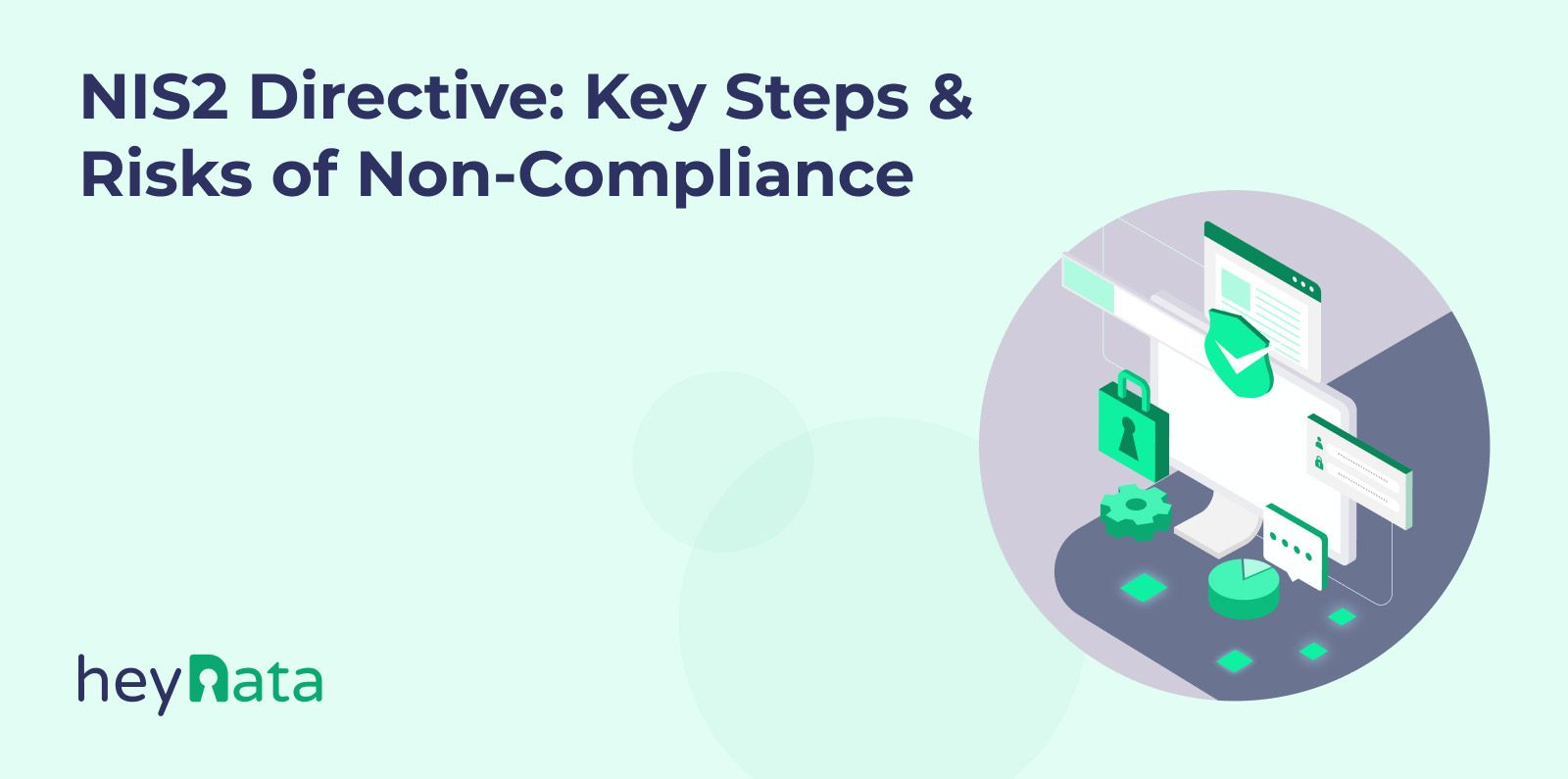
NIS2 Directive: Key Steps & Risks of Non-Compliance

In January 2023, Directive (EU) 2022/2555, known as the NIS2 Directive, was introduced to strengthen cybersecurity among EU member states. It extends its reach by implementing stricter security measures and including more sectors. Impacted organizations must comply with the directive by October 17, 2024.
In our previous article, we discussed the key focus areas of NIS2 in detail and established which businesses will need to comply.
In this article, we will look at possible risks of non-compliance, and steps organizations should take to ensure compliance with the directive.
Table of Contents:
Risks Associated With Non-Compliance
Organizations that fail to comply with the NIS2 Directive face significant risks, impacting not only their financial health but also their operational stability and reputation. Understanding these risks is crucial for businesses aiming to prioritize cybersecurity and adhere to legal standards.
The risks associations with non-compliance include:
- Administrative Fines: Essential entities can be fined up to €10,000,000 or 2% of the total global revenue for the previous year, whichever is higher. Important entities can be fined up to €7,000,000 or 1.4% of the total global revenue for the previous year, whichever is higher.
For example, in 2020, British Airways was fined £20 million for failing to protect the personal and financial details of more than 400,000 of its customers. At the time, this was the largest fines issued by the ICO to date, further underscoring the severe financial repercussions that can arise from non-compliance. - Enforcement Actions: Regulatory bodies may take enforcement actions such as audits or investigations into non-compliant organizations. This can reveal further security lapses, resulting in further scrutiny, mandatory system upgrades and operational disruptions.
- Reputational Damage: In certain cases, regulatory actions may include mandatory public disclosures. Organizations might be required to publicly announce their non-compliance, which can have reputational consequences and affect stakeholder trust.
For instance, in 2018, Facebook CEO Mark Zuckerberg had to testify before the U.S. Congress following the Cambridge Analytica scandal. This incident highlighted significant lapses in data protection and forced Zuckerberg to publicly take accountability for the breach, addressing both legal authorities and the general public. The scandal severely impacted Facebook's reputation and led to increased scrutiny over its data privacy practices. - Operational Disruptions: Failing to implement adequate cybersecurity measures increases the risk of data breaches, where sensitive information is stolen or lost. This can disrupt services, halt business operations and lead to a loss of revenue.
- Personal Sanctions: In cases of gross negligence, NIS2 allows holding top management personally accountable for security breaches, potentially resulting in temporary bans from managerial roles.
Key Steps to Prepare for NIS2 Compliance
With the NIS2 Directive coming into effect on October 17, 2024, organizations must take steps to prepare for compliance.
Step 1: Determine if your organization falls under the NIS2 scope
First, figure out if your company needs to comply with the NIS2 directive. You can do so by reviewing the sectors and size limitations of the directive outlined earlier in our previous article.
If your organization falls under the scope, it is optional to prepare for the directive at this point. However, it may still be beneficial to implement cybersecurity best practices as a proactive measure to protect your business and stakeholders.
If your organization falls under the directive's scope, it's time to assess your current cybersecurity measures.
Step 2: Assess your current cybersecurity measures
Evaluate your current cybersecurity practices and identify any gaps or vulnerabilities. Conduct a thorough risk assessment to understand your organization's potential security risks, the likelihood of an incident, and the potential impact.
Key Areas to Focus On
- Inventory of Assets: List all hardware used within your network and document all applications and systems in use. Identify sensitive data, its storage locations, and access permissions.
- Network Security: Check firewall configurations and update rules if necessary. Ensure Intrusion Detection Systems (IDS) are active and correctly configured. Verify that internal networks are segmented to limit access.
- Access Controls: Audit user roles and access levels to ensure they align with job functions. Review authentication methods, such as multi-factor authentication (MFA). Lastly, evaluate the security of remote access solutions, such as VPNs.
- Data Protection: Assess encryption protocols for data at rest and in transit. Confirm regular backups are performed and stored securely. Confirm measures are in place to detect and prevent unauthorized data transfers.
- Incident Response: Review the incident response plan for completeness and relevance. Ensure the response team is trained and conducts regular drills. Confirm clear communication channels for reporting incidents are in place.
- Employee Awareness: Evaluate the effectiveness of cybersecurity training programs. Conduct regular phishing tests to gauge employee awareness. Monitor adherence to cybersecurity policies across the organization.
- Third-Party Security: Perform security assessments on third-party vendors and partners and ensure their contracts include cybersecurity requirements and SLAs.
You can leverage tools such as Nessus or OpenVAS to identify vulnerabilities in your systems.
By thoroughly assessing these areas, you can develop a clear picture of your organization's cybersecurity posture, enabling you to address identified gaps effectively.
Step 3: Develop a cybersecurity strategy
Based on the outcomes of the assessment, develop a comprehensive cybersecurity strategy that addresses the identified risks. This should include policies, procedures, and technical controls to safeguard critical assets and data.
Once your strategy is in place, implement the necessary security controls and measures.
This may include measures such as access controls, encryption, regular backups, incident response plans, and employee training, as outlined under the key focus areas to focus on in this article.
Remember to evaluate your supply chain and ensure your suppliers are secure as well, as they can also pose a potential risk to your organization's security.
Consider the key focus areas of the NIS2 directive when developing your cybersecurity strategy to ensure compliance.
Step 4: Evaluate, monitor, and maintain compliance
Once you have implemented your compliance strategy, regularly test the compliance measures to ensure their effectiveness and make any necessary adjustments.
Continue monitoring your systems for any potential security breaches or vulnerabilities.
Remember that compliance is an ongoing process, so it's crucial to conduct regular audits and assessments to ensure continued adherence to the NIS2 directive.
By following these steps and staying proactive in your cybersecurity efforts, you can achieve compliance with NIS2 as well as enhance the overall security posture of your organization.
heyData offers support for companies aiming to achieve compliance with NIS2 Directive through its NIS2 Compliance service.
Conclusion
The future implications of NIS2 will significantly shape the cybersecurity landscape in the EU. The NIS2 Directive sets a high bar, making it imperative for organizations to be proactive in their cybersecurity efforts.
Adapting to NIS2 compliance requires organizations to rethink their cybersecurity strategies. Enhanced risk management, corporate accountability, and strong reporting mechanisms are all integral to meeting the NIS2 requirements. This proactive stance on cybersecurity ensures both legal compliance and operational integrity, aligning with the goals set out by the NIS2 Directive.
Lastly, it is crucial to consider the NIS2 Directive not only as a legal obligation but also as a critical investment in your company’s overall security posture and an opportunity to strengthen customer trust and confidence.


